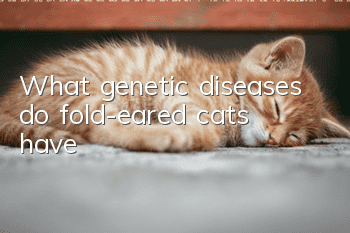What genetic diseases do fold-eared cats have?

Chondrooskeletal dysplasia is a hereditary skeletal disease of cats with folded ears. Its limbs, tail and joint deformities are closely related to the dominant gene for folded ears. In cats with severe disease, the bone lesions will slowly spread to the spine. , paralyzing the cat and causing great pain.
Geneticists have always believed that the occurrence of Scottish fold ear was a mistake. "Cartilage-ossified dysplasia" is a hereditary bone disease of cats with folded ears. Its limbs, tail and joint deformities are closely followed by the dominant gene for folded ears. Symptoms include a stiff tail, severely deformed feet that cannot support the weight of the body, and inward-curved nails that may grow to the point of penetrating the soles of the feet.
This deformity begins to appear gradually when the cat is 2 months old, and the pain is very obvious in pre-adult cats. At present, veterinarians can only use drugs to soothe the condition, help cats reduce pain and slow down the deterioration.
Cats have to spend their entire lives in pain and medication. In some severely ill cats, bone lesions will slowly spread to the spine, paralyzing the cat and causing great pain. When a cat cannot bear the pain, euthanasia may be the most comforting option for the owner.
There is currently no cure for this genetic disease, and most of the disease will continue to get worse. Based on this situation, geneticists call for abandoning the breeding of this cat as the greatest care for cats.
- What are the four essential nutrients for cats?
- Are Ragdoll cats big cats?
- How do you think Garfield is pure or not?
- If your cat licks its fur excessively, prepare a WOWO hair removal cream!
- What will happen if a cat licks an externally dewormed cat?
- Kitten snores while sleeping
- Why does a cat lose its teeth?
- Can Ragdoll cats jump very high?
- It is very important to improve the bad habits training of Siamese cats. Siamese cat training methods!
- Can cats spray flower dew?



